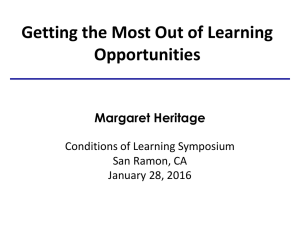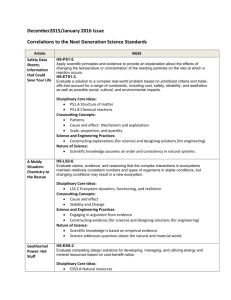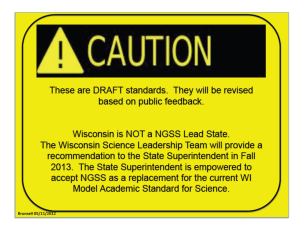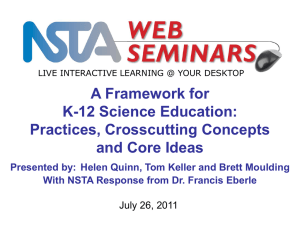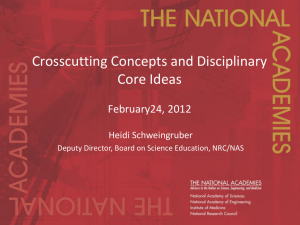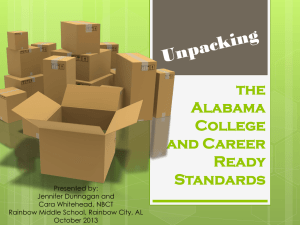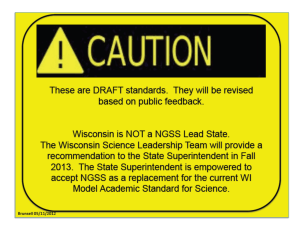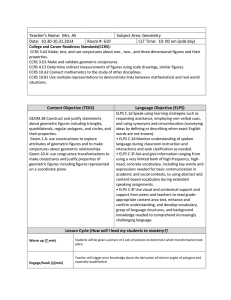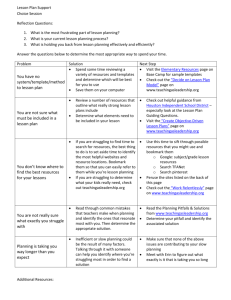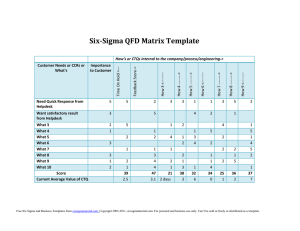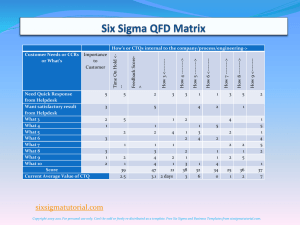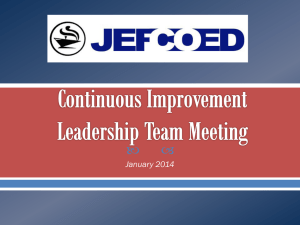K-12 Science
advertisement
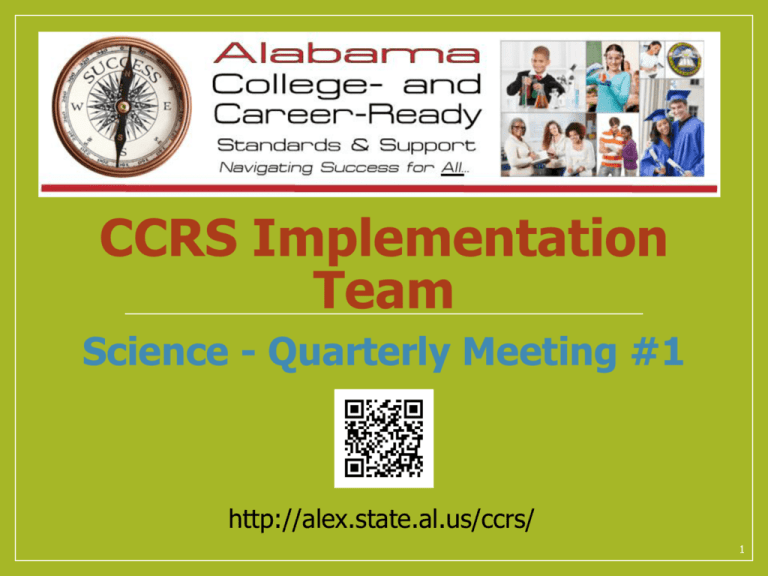
CCRS Implementation Team Science - Quarterly Meeting #1 http://alex.state.al.us/ccrs/ 1 Outcomes • Develop an awareness of the 3 Dimensions of A Framework for K-12 Science Education and its impact on classroom instruction. • Identify how science and literacy are connected. • Identify how the 3 Dimensions of the Framework are integrated in classroom instruction. • Prepare to share research and practice with team members. 2 Participating with Poll Everywhere How to vote via text messaging From a text message From any browser 7474443578 (code or keyword) <your response> How familiar are you with A Framework for K-12 Science Education? www.polleverywhere.com Text a CODE to __________ Know it from cover to 271323 cover! Have touched the content 271325 a few times. Have heard of it but am not 271327 familiar with its content What’s that? 371335 4 Understanding the Framework A Framework for K-12 Science Education …is based on a rich and growing body of research on teaching and learning in science. . . AAAS’s Benchmarks for Science Literacy (1993) National Science Education Standards (1996) Taking Science to School (2007) 6 Current research on science learning recommends… The next generation of science standards and curricula … should be structured to identify a few core ideas in a discipline and elaborate how those ideas can be cumulatively developed over grades K-8. Developers of curricula and standards should present science as a process of building theories and models using evidence, checking them for consistency and coherence, and testing them empirically. Excerpts from Taking Science to School: Learning and Teaching Science in Grades K-8 8 The Framework provides a coherent vision which includes: • Limited number of core ideas • Depth and coherence, not breadth of coverage • Core ideas revisited in increasing depth and sophistication across years; focus on connections • Learners involved in practices that develop, use, and refine the scientific ideas, not “explain” the science for students. 9 Principles of The Framework Children are born investigators Understanding over time Science and Engineering require both knowledge and practice Connecting to students’ interests and experiences is essential Focusing on core ideas and practices Promoting equity 10 3 Dimensions of the Framework 1. Scientific and Engineering Practices 2. Crosscutting Concepts 3. Disciplinary Core Ideas 11 Science & Engineering Practices How they work together… Asking questions and defining problems Using mathematics and computational thinking 1 7 Developing and using models Planning and carrying out investigations 2 Analyzing and interpreting data 6 Constructing explanations and designing solutions Engaging in argument from evidence Obtaining, evaluating, and communicating information 12 Crosscutting Concepts Cause and Effect Patterns Scale and Quantity Systems Change and Stability Structure and Function Matter and Energy 13 Disciplinary Core Ideas Physical Science • PS1: Matter and its Interactions • PS2: Motion and Stability: Forces and Interactions • PS3: Energy • PS4: Waves and Their Applications in Technologies for Information Transfer Life Science • LS1: From Molecules to Organisms: Structure and Processes • LS2: Ecosystems: Interactions, Energy, and Dynamics • LS3: Heredity: Inheritance and Variation of Traits 14 • LS4: Biological Evolution: Unity and Diversity Disciplinary Core Ideas Earth and Space Science • ESS1: Earth’s Place in the Universe • ESS2: Earth’s Systems • ESS3: Earth and Human Activity Engineering, Technology, and Applications of Science • ETS1: Engineering Design • ETS2: Links Among Engineering, Technology, Science, and Society 15 Vision: Science for all students Science, engineering, and technology are cultural achievements and a shared good of humankind Science, engineering, and technology permeate nearly every facet of modern life Understanding of science and engineering is critical to participation in public policy and good decision making More and more careers require knowledge of science 16 Prepared Graduate Defined Possesses the knowledge and skills needed to enroll and succeed in credit-bearing, first-year courses at a two- or four-year college, trade school, technical school, without the need for remediation. Possesses the ability to apply core academic skills to real-world situations through collaboration with peers in problem solving, precision, and punctuality in delivery of a product, and has a desire to be a lifelong learner. 17 Experiencing the Framework • • • • • Anticipation Guide Think – Pair – Share Rubber Band Investigation Tuning Fork Investigation Index Card 18 https://getkahoot.com 19 Lesson Debrief 20 CCRS Teacher/Administrator Surveys How prepared are teachers in your school to teach CCRS to the following groups of students? (from Very Prepared to Not At All Prepared) Students as a whole English Language Learners Students with Disabilities Low-income Students 81% 61% 64% 75% Academically At-Risk Students 75% About 40% do not feel prepared to teach ELL students and Students with disabilities Case Studies A look into how the 3 Dimensions of The Framework are woven together in classroom instruction. 22 Next Steps Target one Science & Engineering Practice and… • one Crosscutting Concept to… infuse into a lesson before returning to next CCRS meeting. • • • Bring a reflection on: What did you choose, • How did you use it, and • How do you think it went? • Bring student work samples, if generated. • 23 Prepare to Share Planning forward • What will you recommend to your team for how this should be shared in your LEA? 24
